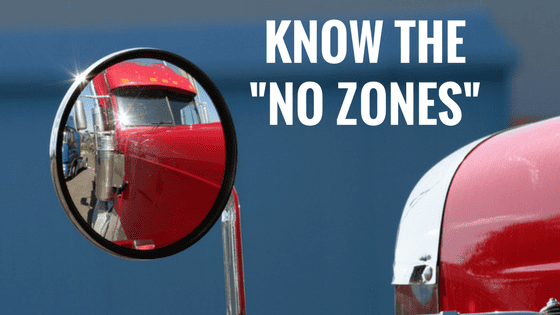Truck drivers know that staying safe on the road is always the number one priority of the job. But sometimes, safety is a two-way street between a truck driver and the passenger cars he shares the road with. Through years of experience and research, it’s evident that there are several folks who don’t understand the dangers of blind spots and the potential consequences of being tied up in a truck driver’s blind spot.
According to the National Highway Traffic Safety Administration, there are approximately 840,000 side-to-side blind spot collisions with 300 fatalities every year in the United States. Many of these accidents involve the collision with a semi truck and more than likely could have been avoided if everyone had an understanding of big rig’s “no zones”.
The Front
We get it, being stuck behind a semi truck can really slow you down; however, the absolute worst thing a passenger car can do is pass a truck and then cut him off – even worse is cutting him off and then slowing down. Both are big no-nos for 2 reasons: the first 25 feet (give or take) in front of a truck is a blind spot and if the truck has to suddenly stop or slow down (because someone cut him off), it takes a lot more effort, space and time to slow down. This is what causes accidents. Best practices suggest that when passing a semi, you should allow at least 1 car length per 10 mph of your driving speed.
The Back
Traveling too close to the rear of a semi is particularly dangerous for the passenger car. Because you’re riding too close, you are blocking your view of what’s ahead of you; which will shorten your reaction time if the rig in front of you stops abruptly. Additionally, if you’re behind a rig and you can’t see it’s mirrors, then the driver of the rig can’t see you. About 200 feet behind a semi truck is considered it’s no zone, so be sure to give enough clearance.
The Sides
The last places to linger while driving is at the sides of a tractor trailer. The blind spots on the sides of semi truck are much longer than you would expect. If you can’t see the driver in his side mirrors, then he more than likely can’t see you. So when you’re passing a big rig, it’s best to do so quickly so that you can get back into visibility range as fast as possible.
As the largest truck blind spot, it is crucial that drivers avoid passing on the right side. If you can’t see the truck driver in his side mirror, it is safe to say he can’t see you either. If you have to pass, make sure you pass on the left side. Try to avoid driving alongside a truck on the right side, even on large-lane highways, as they have practically no visibility.
Additional Tips for Passenger Cars:
- Don’t tailgate.
- Be sure to give trucks plenty of space when driving in front of them.
- If you can’t see the truck’s mirrors, you’re too close!
- When passing a truck, don’t diddle doodle. Pass quickly.
- If you’re in a blind spot, and the driver is moving toward you, honk your horn to give an alert that you’re there.
- When a truck is making a right turn, be sure to give plenty of space so they can “swing wide” to avoid hitting the curb.

